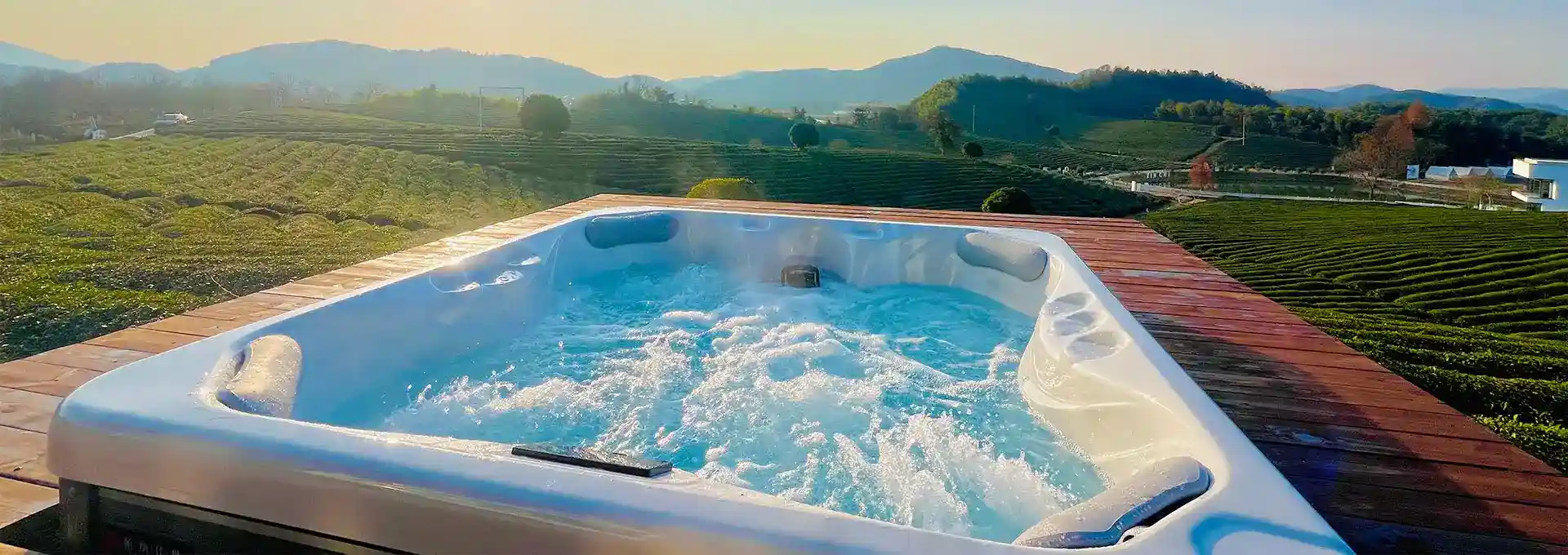Why Does My Swim Spa Keep Getting Hotter?
2024-09-19 16:56:20
If you've noticed your swim spa consistently increasing in temperature beyond your set point, you're not alone. This common issue can be frustrating for swim spa owners, potentially impacting both comfort and energy efficiency. Understanding the causes behind this unexpected heating can help you maintain optimal conditions in your backyard oasis. Let's dive into the reasons behind this phenomenon and explore some related questions about backyard swim spa maintenance and enjoyment.
What are the benefits of a backyard swim spa?
Before we delve deeper into temperature issues, it's worth highlighting why so many homeowners are drawn to backyard swim spas in the first place. These versatile aquatic installations offer a unique blend of relaxation, exercise, and entertainment, all within the convenience of your own property.
One of the primary benefits of a backyard swim spa is its ability to provide a full-body workout in a compact space. Unlike traditional swimming pools, swim spas use powerful jets to create a current that you can swim against, effectively allowing you to "swim in place." This feature makes them ideal for fitness enthusiasts, athletes in training, or anyone looking to incorporate low-impact cardiovascular exercise into their routine. The resistance provided by the current can be adjusted to suit different fitness levels, making it accessible for beginners and challenging for advanced swimmers alike.
Beyond exercise, swim spas offer exceptional relaxation opportunities. Many models come equipped with hydrotherapy jets strategically placed to target different muscle groups, providing a soothing massage experience. After a long day or an intense workout, you can unwind in the warm, bubbling water, letting the jets work out any tension or soreness. This combination of exercise and relaxation in one unit makes swim spas a versatile addition to any backyard.
Swim spas also serve as excellent social hubs for family and friends. Their compact size makes them more intimate than large pools, encouraging conversation and interaction. Many models feature built-in seating areas, perfect for lounging and chatting. Some even come with entertainment systems, allowing you to enjoy music or watch movies while soaking. For families with children, swim spas provide a safe environment for water play and swimming lessons, as the depth is typically consistent and more manageable than a full-sized pool.
From a practical standpoint, backyard swim spas are often more cost-effective and easier to maintain than traditional pools. They require less space, making them suitable for smaller yards or properties with limited outdoor areas. The installation process is generally simpler and less disruptive than excavating for a pool. Additionally, swim spas can be used year-round in many climates, especially when equipped with heating systems, extending their value beyond just the summer months.
Lastly, swim spas can add significant value to your property. They're seen as desirable features in the real estate market, potentially increasing your home's resale value. The combination of aesthetic appeal and functional benefits makes them an attractive selling point for potential buyers who are looking for homes with built-in lifestyle amenities.
How do I maintain the right temperature in my swim spa?
Maintaining the correct temperature in your swim spa is crucial for comfort, energy efficiency, and the longevity of your equipment. While it's concerning when your swim spa keeps getting hotter, understanding the factors that influence temperature and implementing proper maintenance practices can help you keep things under control.
First and foremost, it's essential to have a reliable and accurate thermometer or temperature sensor in your backyard swim spa. Many modern swim spas come with built-in digital temperature displays, but it's always a good idea to double-check with a separate thermometer to ensure accuracy. This will help you monitor any unexpected temperature fluctuations more effectively.
One of the primary factors in temperature control is your swim spa's thermostat and heating system. Like any mechanical component, these can sometimes malfunction or become less accurate over time. Regularly inspect and clean your heating system according to the manufacturer's instructions. This may involve removing debris from filters and checking for any signs of wear or damage. If you notice persistent temperature issues, it might be worth having a professional technician inspect and calibrate your heating system.
The cover of your swim spa plays a crucial role in temperature regulation. A well-fitted, insulated cover helps retain heat when the spa is not in use, preventing unnecessary energy expenditure to maintain temperature. However, if the cover is old, damaged, or doesn't fit properly, it can trap too much heat, causing the water temperature to rise unexpectedly. Inspect your cover regularly for signs of wear and tear, and replace it if necessary. Some swim spa owners use solar covers during the day to harness the sun's energy for heating, but be cautious not to overuse these in hot weather, as they can contribute to overheating.
Water circulation is another key factor in maintaining consistent temperature. Ensure that your swim spa's pumps and jets are functioning correctly and that water is circulating efficiently. Poor circulation can lead to hot spots and uneven heating. Regular cleaning of filters and skimmers will help maintain proper water flow and prevent debris from interfering with the heating system.
Pay attention to the ambient temperature and sunlight exposure of your swim spa. If it's located in an area that receives direct sunlight for extended periods, especially during hot summer months, this can contribute to unexpected temperature increases. Consider using shade structures or relocating the swim spa if possible to mitigate this effect.
Proper chemical balance is not only important for water hygiene but can also impact heating efficiency. Imbalanced water chemistry can lead to scale buildup on heating elements, reducing their efficiency and potentially causing them to work harder, leading to overheating. Regularly test and adjust your water chemistry according to recommended levels.
Lastly, be mindful of how you use your backyard swim spa. Frequent use of high-powered jets, especially in warmer weather, can cause the water temperature to rise due to the energy transferred by the pump motors. If you notice the temperature climbing during extended use, consider taking breaks or adjusting the jet power to allow the system to stabilize.
By implementing these maintenance practices and being attentive to your swim spa's behavior, you can better control its temperature, ensuring a comfortable and enjoyable experience every time you use it.
What is the ideal temperature for a swim spa?
Determining the ideal temperature for your swim spa depends on various factors, including personal preference, intended use, and even the time of year. Unlike traditional pools, which are often kept at cooler temperatures, swim spas offer the flexibility to adjust the heat to suit different activities and comfort levels.
For general use and relaxation, many swim spa owners find that a temperature range between 85°F to 95°F (29°C to 35°C) provides a comfortable environment. This range allows for a pleasant soaking experience without being too warm for light exercise or play. However, personal preferences can vary widely, and some users might prefer temperatures slightly above or below this range.
When it comes to serious swimming and exercise, cooler temperatures are typically more appropriate. Many fitness enthusiasts and athletes prefer temperatures between 78°F to 84°F (26°C to 29°C) for lap swimming or aquatic workouts. This cooler range helps prevent overheating during intense physical activity and allows for longer workout sessions without excessive fatigue.
For therapeutic purposes, such as hydrotherapy or relief from muscle soreness, warmer temperatures are often preferred. In these cases, temperatures between 95°F to 104°F (35°C to 40°C) can be beneficial. The warmth helps to relax muscles, increase blood flow, and provide a soothing environment for recovery. However, it's important to note that prolonged exposure to very warm water can lead to dehydration and other health concerns, so it's advisable to limit sessions at higher temperatures and stay well-hydrated.
Seasonal considerations also play a role in determining the ideal temperature. During colder months, you might prefer a warmer setting to create a cozy retreat from the chilly air. Conversely, in hot summer weather, a cooler temperature can provide refreshing relief and make your backyard swim spa more inviting for regular use.
It's worth noting that energy efficiency is another factor to consider when setting your swim spa's temperature. Higher temperatures require more energy to maintain, which can lead to increased utility costs. Finding a balance between comfort and efficiency often involves experimenting with different settings to see what works best for your usage patterns and climate.
For families with children or elderly users, it's crucial to err on the side of caution with temperature settings. The U.S. Consumer Product Safety Commission recommends that spa water temperatures never exceed 104°F (40°C) for safety reasons. Children, in particular, are more sensitive to heat and may not recognize when they're becoming overheated, so a more moderate temperature is advisable when kids will be using the swim spa.
Ultimately, the ideal temperature for your swim spa is a personal decision that may vary depending on your specific needs and preferences. Many swim spa owners find that adjusting the temperature based on planned activities – cooler for exercise, warmer for relaxation – provides the most versatile and enjoyable experience. Modern swim spas often come with programmable temperature controls, allowing you to preset different temperatures for various times of day or specific uses.
Remember, regardless of the temperature you choose, it's essential to monitor how you feel while using the swim spa. If you start to feel uncomfortably warm, lightheaded, or fatigued, it's best to exit the water and allow your body to cool down. Staying hydrated and limiting session times, especially in warmer water, will help ensure a safe and enjoyable swim spa experience.
By understanding the factors that influence temperature preferences and being willing to experiment with different settings, you can find the perfect balance that makes your backyard swim spa a year-round source of relaxation, fitness, and enjoyment for you and your family.
For more information on hot tub installations and to find out more about our products, please feel free to contact us at info@iparnassus.com.
References
1. American Red Cross. (2023). Swimming and Water Safety Manual.
2. U.S. Consumer Product Safety Commission. (2022). Safety Barrier Guidelines for Residential Pools.
3. Swim University. (2024). The Ultimate Guide to Swim Spa Maintenance.
4. Energy.gov. (2023). Energy-Efficient Pool and Spa Tips.
5. Aqua Magazine. (2024). Best Practices for Swim Spa Temperature Management.
6. Journal of Physical Therapy Science. (2022). Effects of Aquatic Exercise on Health-Related Physical Fitness.
7. International Journal of Aquatic Research and Education. (2023). Safety Considerations for Aquatic Facilities.
8. Swimming World Magazine. (2024). Training Tips for Swim Spa Workouts.
9. Arthritis Foundation. (2023). Warm Water Exercise for Arthritis Relief.
10. Environmental Protection Agency. (2024). Water Efficiency in Recreational Water Use.



